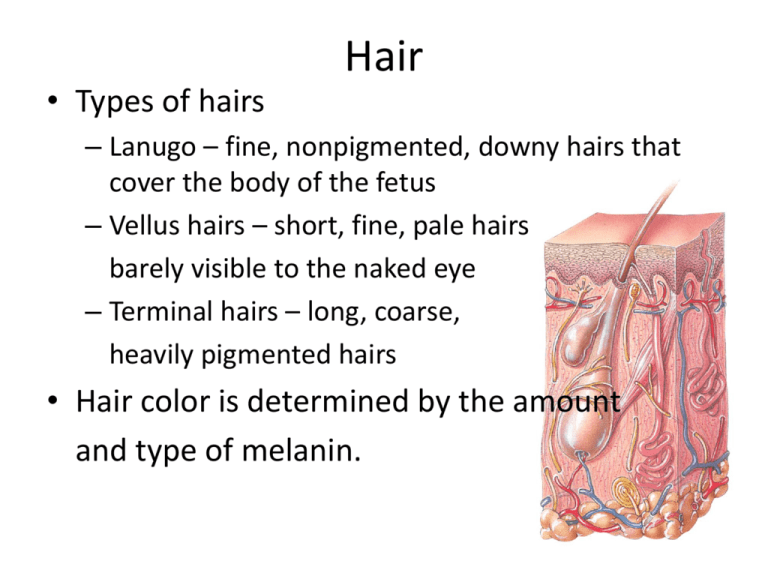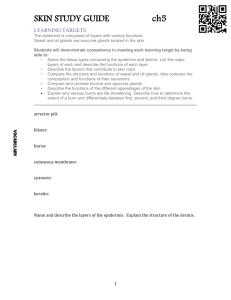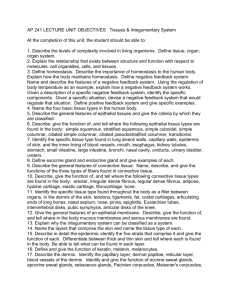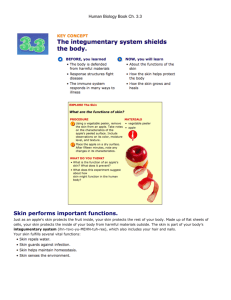
• Types of hairs
Hair
– Lanugo – fine, nonpigmented, downy hairs that
cover the body of the fetus
– Vellus hairs – short, fine, pale hairs
barely visible to the naked eye
– Terminal hairs – long, coarse,
heavily pigmented hairs
• Hair color is determined by the amount
and type of melanin.
Skin Glands
• Recall from Chapter 4 that glands are epithelial
cells that secrete a substance.
• Sebaceous (oil) glands are connected to hair
follicles.
– They secrete an oily substance called
sebum which does 2 important things:
• Prevents dehydration of hair
and skin
• Inhibits growth of certain bacteria
Skin Glands
• In addition to oil glands, there are 2 types of skin
sweat glands (also called sudoriferous glands).
Both are simple, coiled tubular glands.
– Eccrine sweat glands are the most numerous. They
secrete a watery solution (600 ml per day) that helps to
cool the body and eliminates small amounts of waste.
– Apocrine sweat glands are located mainly in the skin of
the axilla, groin, areolae, and bearded facial regions of
adult males. They secrete a slightly viscous sweat.
Skin Glands
• Eccrine sweat glands release sweat in response
to an emotional stress such as fear or
embarrassment. This type of sweating is
referred to as emotional sweating or a “cold
sweat”.
• The secretory portion of apocrine sweat
glands is located mostly in the subcutaneous
layer, and the excretory duct opens into hair
follicles, with sweat secreted during emotional
stress and sexual excitement.
– Much of body odor is due to apocrine sweat.
Skin Glands
• Ceruminous glands are modified sweat glands
located in the ear canal.
– Along with nearby sebaceous glands, they are
involved in producing a waxy secretion called
cerumen (earwax) which provides a sticky barrier
that prevents entry of foreign bodies into the ear
canal.
Nails
• Nails are composed of hard, keratinized
epidermal cells located over the dorsal
surfaces of the ends of fingers and toes.
• Nail structures include:
– Free edge
– Transparent nail body (plate)
with a whitish lunula at its base
– Nail root embedded in a fold of skin
Nails
Anatomy Overview:
Interactive Animation
• The Integument and Disease Resistance
You must be connected to the internet to run this animation
Maintaining
Homeostasis
Skin damage sets in motion a sequence of events that repairs the skin to its
normal (or near-normal) structure and function.
Wound Healing
• Two kinds of wound-healing processes can
occur, depending on the depth of the injury.
– Epidermal wound healing occurs following
superficial wounds that affect only the epidermis.
• Return to normal function is the rule.
– Deep wound healing occurs when an injury extends
to the dermis and subcutaneous layer.
• Loss of some function and development of scar tissue is
the rule.
Wound Healing
We will observe similar attempts at homeostasis in all the organ systems we
study for the remainder of the year.
Wound Healing
We will observe similar attempts at homeostasis in all the organ systems we
study for the remainder of the year.
Burns
• A burn is tissue damage caused by excessive
heat, electricity, radioactivity, or corrosive
chemicals that denature (break down) the
proteins in the skin cells.
– Burns destroy some of the skin's important
contributions to homeostasis—protection against
microbial invasion and desiccation, and
thermoregulation.
• Burns are graded according to their severity.
Burns
• A first-degree burn involves only the epidermis
– It is characterized by mild pain and erythema
(redness) but no blisters and skin functions remain
intact.
Burns
• A second-degree burn destroys the epidermis
and part of the dermis - some skin functions are
lost.
– Redness, blister formation, edema, and pain result.
Burns
• A third-degree burn is a full-thickness burn
(destroys the epidermis, dermis, and
subcutaneous layer).
– Most skin functions are lost, and the region is numb
because sensory nerve endings have been
destroyed.
Burns
• According to the American Burn Association's
classification of burn injury, a major burn
includes:
o
– 3 burns over 10% of body surface area; or
o
– 2 burns over 25% of body surface area; or
o
– Any 3 burns on the face, hands, feet, or perineum
(which includes the anal and urogenital regions)
• When the burn area exceeds 70%, more than
half the victims die.
Burns
• A quick means for estimating the surface area
affected by a burn in an adult is the rule of
nines:
– Count 9% if both the anterior and posterior surfaces of the head and
neck are affected.
– Count 9% for both the anterior and posterior surfaces of each upper
limb (total of 18% for both upper limbs).
– Count four times nine or 36% for both the anterior and posterior
surfaces of the trunk, including the buttocks.
– Count 9% for the anterior and 9% for the posterior surfaces of each
lower limb as far up as the buttocks (total of 36% for both lower limbs).
Burns
Development of the
Integumentary System
• The epidermis develops from the ectoderm.
– Nails, hair, and skin glands are epidermal derivatives.
• The dermis develops
from the mesoderm.
Aging
• The integumentary system changes with age:
– Wrinkles develop.
– Dehydration and cracking occurs.
– Sweat production increases.
– An increase in the numbers of functional
melanocytes results in gray hair and atypical skin
pigmentation.
– Subcutaneous fat is lost, and there is a general
decrease in skin thickness.
– Nails may also become more brittle.
Aging
• With age, there is also an increased
susceptibility to pathological conditions (as
demonstrated by this decubitus ulcer).
– These type of pressure
ulcers (“bed sores”)
are an all-to-common
occurrence in
nursing homes.
End of Chapter 5
Copyright 2012 John Wiley & Sons, Inc. All rights reserved.
Reproduction or translation of this work beyond that permitted in
section 117 of the 1976 United States Copyright Act without
express permission of the copyright owner is unlawful. Request for
further information should be addressed to the Permission
Department, John Wiley & Sons, Inc. The purchaser may make
back-up copies for his/her own use only and not for distribution or
resale. The Publisher assumes no responsibility for errors,
omissions, or damages caused by the use of these programs or
from the use of the information herein.










